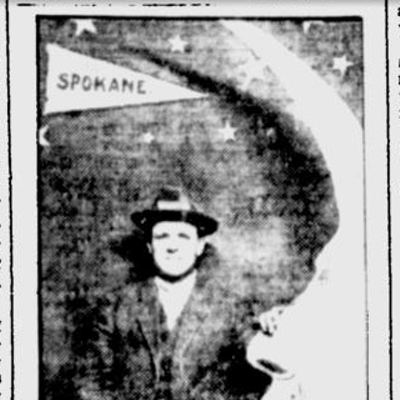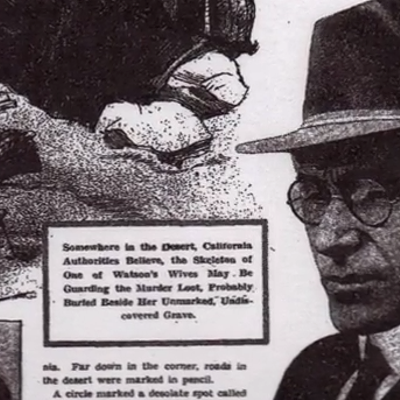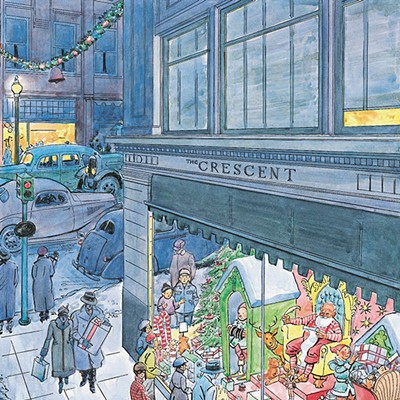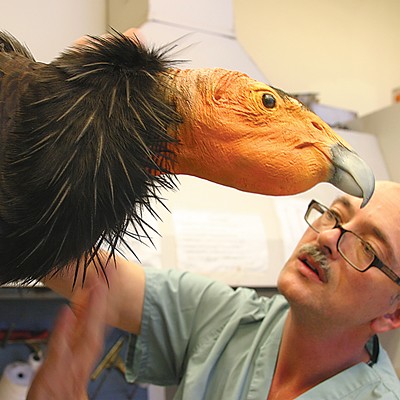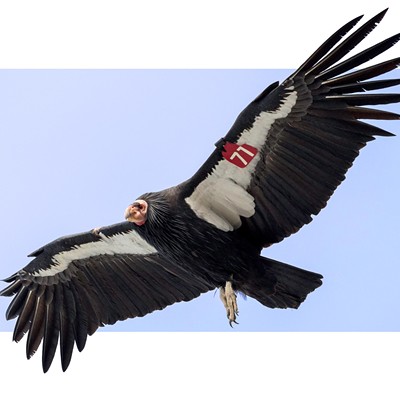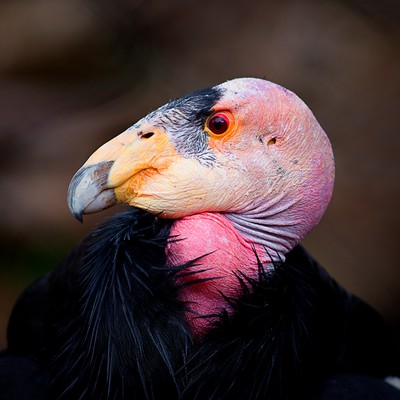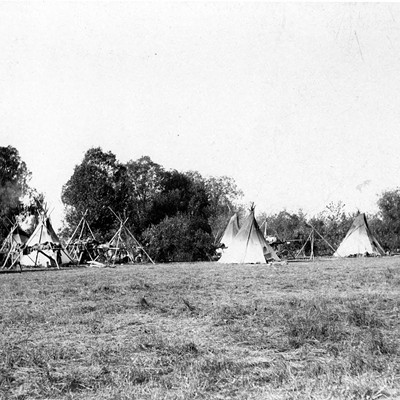In the early spring of 1873, Mr. James Glover and a companion rode through the eastern reaches of Washington Territory. The forested slopes of Tekoa Mountain flanked them on one side, and the bunchgrass mounds of the Palouse Hills rolled off to the south. Following the course of a pleasant creek, they stopped to watch a native dig new shoots of balsamroot sunflower from a sunny hillside. They had seen nothing but wild country for many miles when they came upon a man building a temporary cabin out of little poles brought down from the mountains. "He and his family were glad to see us, like all newcomers in this country who were just beginning to get little places fixed up." This was the family of Henry Coplen, recently arrived from the Dayton area of Washington Territory to join two older sons who had built a home in the valley the previous fall. After a stop for lunch, Mr. Glover continued north to purchase the townsite of Spokane Falls; the next summer, young Alonzo Coplen helped drive a wagon there to buy siding and flooring from Glover's new sawmill.
The valley where the Coplens were homesteading was called Latah, "place where we get food," by the Coeur d'Alene Indians, but its stream had been known as Hangman Creek since the summary execution of the Spokane leader Qualchan on its banks during the bitter conflict of 1858. Whatever feelings lingered from that incident, Henry Coplen made it a point to remain cordial with the tribe, and over the next few years native travelers often spent the night on his hearth.
The spring of 1876 was an unusually wet one for Eastern Washington, and perhaps it was the high water that drew the Coplen brothers down near the creek to a peculiar boggy piece of land where cattle sometimes got mired. Looking back, Alonzo thought it was simple curiosity that precipitated the great adventure that began there. "It was a peat formation," he later recalled, "raised a little above the level of the flat, and the top shook when one walked on it." His older brother Ben described a cluster of springs, the mouth of each one puckered a few feet above the surface of the marsh.
One afternoon in May, the brothers began to probe one of the muddy springs with a long pole. Their rod sank through the green mat of sedges and beyond, hissing down to a depth of eight feet. With one of the thrusts, it struck something hard. Their interest piqued, the brothers mucked back to the barnyard and attached a large iron hook onto the end of their probe. They plunged this new implement into the morass, grappled about, and coaxed a large object to the surface. Upon examination it turned out to be an enormous backbone, far too large for any elk, ox or cow. Back down went the polehook, and this time an outsized shoulder blade emerged, two feet long and almost as wide. Finally they extracted a thick chunk of ivory. Writing to an acquaintance in Walla Walla, they reported, "We have found the bones of a very large animal."
There was no stopping them now. Thirty-three-year-old Ben, who had worked a stint in the Colorado silver mines, outlined a plan to drain a section of the bog. Luckily, he had a crew of siblings to help: Lewis, 29; George, 20; Alonzo, 13; and Isaac, 8. Beginning on the shore of the creek, 250 feet away from their find, they set to work slicing a deep channel through the wetland. To keep the walls of the fresh ditch from collapsing, they drove stakes along both sides, then stuffed brush tight behind them. After working their way down through the black topsoil, they shoveled through a layer of fibrous peat, then a stratum of pure white volcanic ash 16 inches thick, then another peat layer that was speckled with woody debris. At a depth of around 10 feet they bottomed out on a bed of gravel, and began trenching steadfastly toward the targeted springhole. Alonzo later recalled that about halfway there, they discovered "a large stone spearhead, several stone arrow heads and a small human skull" lying on the gravel layer. Just beyond these startling finds, their shovels struck an area where the sand and gravel were blackened by what Alonzo took to be ashes and carbon from a prehistoric camp fire. The budding archaeologists collected the artifacts and kept digging, holding their course for the enigmatic spring.
The excavation continued through the long days of June, and when their ambitious trench finally reached the vicinity of the original discoveries, the brothers hit a mother lode of curious bones. Some of them lay in the seeping spring water, and were solidly fossilized; others were embedded in the peat, and crumbled to pieces when the brothers tried to move them — Ben later characterized them as "soft like soap." It soon became apparent that more than one animal lay buried in the bog, and before long more than 100 bones, including seven "horns," were drying in the bunchgrass. A visitor to the site commented that "The horns were sort of tusks, and... were worn away several inches deep at the bottom of the turn or half circle, indicating constant use by rubbing on the ground or rocks." Smaller bones included "the remains of a cave bear, hyena, extinct birds and a sea turtle." Neighbors arrived from miles around to gawk at the humongous specimens, and at some point the brothers decided they should exhibit this wonderful menagerie around the countryside.
Ben Coplen, a widower with wild eyebrows who had lived all over the West, was by all accounts an engaging and gregarious character. He was probably the catalyst for the tour, but Lewis pitched in as well. The three entrepreneurs loaded one of the farm wagons with the best of their big bones, tossed a tent on top, and took off for Walla Walla.
They rattled west to the nascent town of Rosalia, then turned toward Colfax, 30 miles farther south in the heart of the Palouse. Although only a half-dozen years old, its population reached well over 100 souls, and it already boasted a flour mill, a sawmill, two general stores and kerosene street lights. Apparently one of the first things Ben and Lewis did when they arrived on June 26 was find a scale and enlist volunteers to help them weigh and measure the bones. The "horn" they had brought weighed 145 pounds and measured 10 feet along the outside of its curve; the pelvis tipped the scales at 135, followed by a jawbone (63 pounds) and a shoulder blade (40 pounds). A single small tooth, only half the size of the ones still set in the jaw, weighed 10 pounds.
At least three onlookers in Colfax that weekend were sufficiently impressed by the exhibit to fire off letters to their favorite newspapers. J.H. Kenedy, who helped to weigh the bones, postulated in Salem's Daily Oregon Statesman that they belonged to "animals known by antiquists as the behemoth." The correspondent to the Walla Walla Union reported that the pelvis had "an opening through which a man can pass by stooping somewhat." This writer was the first to use the word "mammoth" to describe the bones, and knew enough about extinct pachyderms to distinguish its teeth from those of a mastodon. The Portland Oregonian headlined their report THE CENTENNIAL MAMMOTH, connecting the great beast with the nation's upcoming anniversary. This article was penned by a recent graduate of Corvallis College named James Edmiston, who used scientific terms like "processes" and "cartilaginous surface" to describe the vertebrae, and then pondered whether he was looking at a horn or a tusk. But Edmiston was not all scientific jargon; after measuring the massive thickness of one mandible, he caved in to the temptation for wordplay: "This may be more jawbone than you like to take, but existing facts cannot be avoided."
As news of General Custer's defeat at the Little Big Horn roared across the countryside, the wagonload of bones crossed the swollen Snake River on the Penewawa toll ferry. From there the brothers made for Dayton, close to their previous home on Pettit Creek. They certainly would have had some old friends there to show off their bones to, and during their brief stay a photographer named William O. Matzger took pictures of the relics. Like the Colfax correspondents, Matzger had a keen interest in scientific matters, and as soon as he developed his plates he dispatched copies east to Yale University via the overland stage.
The brothers arrived in Walla Walla just in time for the Fourth of July Centennial extravaganza, which drew a crowd estimated at 3,000 to 5,000 souls for the biggest celebration in the Inland Northwest. After a Brass Band and Glee Club performance of patriotic odes, the afternoon parade of Uniques and Horribles marched down Main Street, led by a small monkey turning handsprings, marshaled by a man in a gorilla suit, and "gravely followed by a baby elephant." Somewhere amid the fanfare, local photographer Leo Schumacher discovered the Coplens and their own elephantine display. Within a few days, fresh prints labeled "the biggest 'horn' ever taken" and "the biggest jawbone in the country" graced the front of his gallery. The local Statesman Weekly could only comment "As for the horn we do not doubt its size, but we know that there are lots of men in this country who can show more 'jaw-bone.'"
Back in Latah two weeks later, Mr. Philip Ritz, out collecting grain samples for the Centennial Exposition in Philadelphia, stopped by to view "the great unknown bones." He found the brothers opening up a new pit that was already yielding fossils only four feet below the surface. Two "truly wonderful" tusks looked to be nearly 12 feet long, but only one could be extracted without destroying it. They had also discovered "the head of the monster," but the skull was too rotten to move and was left in "the black, oozy mud where it was deposited ages ago."
The excavation site was apparently a magnet for visitors, and James Edmiston of Colfax arrived for a second look at the bones. After examining a fresh pair of teeth, he concluded that the elephants emerging from the bog belonged to the species Elephas primigenius — the name that the scientific community had assigned to the woolly mammoth. (It would be many years before mammoths assumed their current genus name of Mammuthus.) Edmiston mentioned one more tantalizing find: a piece of charcoal that looked as if it had been scored by some sort of primitive tool. Wrapping up his letter to the Oregonian, he reported that "many other persons in this country remember they have taken out very large bones... I have no hesitancy in saying here is a large field for the geologist."
Before any geologists could arrive in the field, another pair of locals responded to the lure of curiosity. William and Thomas Donahoe, Irish immigrants from Quebec, were homesteading near the town of Rosalia, only 12 miles west of Latah. In a 1930 interview, Tom Donahoe recalled that when he and Bill heard about the Coplen discovery, they thought of their own spring beside Pine Creek, about 20 feet deep with a clean sandy bottom. The brothers bolted sturdy hooks onto long poles and began to probe, Coplen-style. They soon hooked onto something solid beneath the sand. For the next two days the Donahoes tugged and pulled, constructing a farmer's arsenal of levers and gantries and calling on seven able-bodied neighbors to help. But even the combined efforts of nine grown men could not raise the object. "We found that would not do, so we started to ditch it. We expect to have it ditched and the bones out in 8 days," the brothers reported in a letter to Walla Walla. When they finally extricated the treasure, it was the biggest thing anybody had ever seen, a gargantuan skull that measured 35 inches between the eyes, 50 inches between the ears, and three and a half feet from the back of the head to the front of the nose. Even though its tusks had been torn off during the extraction, the Donahoes estimated the weight of their prize as a jaw-dropping 500 to 600 pounds.
So another set of brothers found themselves astonished and eager to see more. Another amazing assortment of bones piled up around a spring, including a femur as tall as a man. Another set of curious onlookers gathered around. "About the time we had most of the bones fished out," Tom remembered, "here comes a fellow with a band of sheep, headed for Montana. When he saw those bones, he just went wild, mind you. He wanted to trade those sheep, 700 of them, for a third interest in the elephant bones. He had a partner and we said he'd better wait and talk it over with him before he made a deal, but he was dead set on getting in on the fortune from the fossils. He was lucky we didn't take him up."
It is hard to say who was the lucky party — the very next week, a Walla Walla paper reported that the price of sheep had reached its lowest level in 10 years. But if the Donahoes hesitated to jump at the first offer dangled in front of them, they were not immune to the idea of commerce. Tom told a visitor that they were confident they were sitting on a bonanza, and by the end of the summer a second set of brothers began thinking of mounting a tour of their own.
At around the same time that the Donahoes were hoisting the giant skull from their spring, Ben Coplen arrived back in Walla Walla to show off his most recent diggings, including five more tusks as well as an assortment of ribs, teeth and vertebrae. "Our country is famous for bones if not money," crowed one editor, as widespread reports of the two incredible discoveries continued to appear in regional newspapers. On August 12, the Walla Walla Union reported that Yale Professor James Dwight Dana had responded to the Dayton photographs with his opinion that the bones belonged to "the extinct American Elephant or Mammoth." Other people had different interpretations; on the same day, the Eugene City Guard informed its readers that the prehistoric relics certainly belonged to a unicorn.
In mid-August, Ben Coplen arranged free transport for his treasures on a steamboat down the Columbia. Ben was not alone — according to Alonzo, a neighbor named Bill Bohard had bought out Lewis's share in the enterprise, and it seems possible that brother George went along as well. Whoever comprised the troupe, they billed themselves as "the Coplen Bros.," and downstream at The Dalles, they found an empty storefront near Snyder's Restaurant on Main Street to display their "Antediluvian Bones." Residents of The Dalles were no strangers to such relics. Until 1874, Thomas Condon, a minister and enthusiastic geologist, had maintained a fossil museum in his home there, educating both locals and tourists in the wonders of what he called "the secret history of Oregon."
Soon after the Coplens set up shop, the Weekly Tribune ran a solid paragraph of now-familiar weights and measurements, adding a calculation of 20 tons as a live weight for the beast and musing about the mysteries of the fossilization process. The brothers clearly understood the mesmerizing lure of their fossils, especially to youngsters, and followed in the Rev. Condon's footsteps by inviting all the Sabbath School children to view the bones for free on Saturday afternoon. As the exhibit drew to a close, a Dalles editor bid the "pleasant and well-informed gentlemen" a fond farewell.
Then it was off to Portland, where their exhibit drew a thoughtful review in the Evening Standard. When that curious reporter speculated about the roles of climatic change and early man in the extinction of prehistoric mammoths, he raised issues that are still being debated today.
The last week of September was county fair time, and the Coplens carted their relics to the Hillsboro fairgrounds. Newspaper accounts listed as attractions the "huge prehistoric bones," a world-renowned fire-eater and an 800-pound woman. Montgomery Queen's Circus arrived, with his "Centennial on Wheels and his Aggregation of Transcendental Elegance." Also present was a traveling museum of "100,000 Curiosities" from Portland under the command of Col. T.A. Wood, a former minister who had turned to museum curation after damaging his voice. Amid all the excitement, state senator Kelly showed up one afternoon to stoop through the pelvis of the behemoth.
From Hillsboro, the Coplens moved on to Salem, where they were joined by Thomas Condon, now a professor at the new state university in Eugene. Professor Condon set forth his opinion that the Northwest was once thickly populated with mammoths, and described how the beasts might have met their death by becoming mired in bogs. Although the Coplen bones were not as thoroughly petrified as some fossils, Condon believed that there was not another collection to match it in the United States.
The Walla Walla County Fair ran during the same week as its Hillsboro counterpart, and numbered among its exhibits was the Donahoe brothers's fabulous fossil collection. Bill and Tom had rented a booth and hired a "ballyhooer" to bark in the crowds. Their ponderous skull, glittering with "gold and silver quartz in profusion," provided the main attraction, but the brothers also had wired together three leg bones for full effect. One reporter calculated that the live animal "must have been two sizes larger than the Court House." When the fair was over, Tom Donahoe figured that he made about $112 for his efforts. He and his newly married brother proceeded to sell their entire lot of fossils to a man named Nathaniel Thwing for the sum of $700 — about the same price as a herd of sheep. Without wasting any time, Mr. Thwing packed the bones and booked steamboat passage to Portland.
When the great Centennial Fair opened in Salem on October 10, the Coplen and Donahoe bones were united under the same circus tent. The Coplens handled their collection personally; Nathaniel Thwing and an associate named John Hancock displayed the Donahoe specimens. Such familiar faces from the fair circuit as Wood's Museum and Montgomery Queen's Circus were on hand, along with horse racing, needlework prizes and agricultural machinery. "The rival big bones men" garnered several notices in the Fairground Jottings of local papers, noting their interest to scientists and thinkers. One such thinker, identified as Dr. Davis, "the philosopher of Harrisburg," theorized that "the bones of the prehistoric brute found in Washington Territory... came from the moon when the continent of Africa came down after a volcanic eruption."
As the fair came to a close, "the big bones men" headed off in opposite directions. The Coplen Bros. moved south on a tour of the Willamette Valley, with plans to visit Albany, Harrisburg, Junction City and Eugene City. On October 20, the Albany Register waxed enthusiastic: "For great curiosities don't fail to call and see the display of fossils on Broadalbin Street... You never saw anything like it." The next day, the Eugene City Guard announced the imminent arrival of the Coplen collection in their town.
But somewhere between Albany and Eugene City, something happened to change their plans. Perhaps it was the "Webfoot" weather — it had rained almost every day since the fair ended — or perhaps they felt the need to get back home in time to vote in what was shaping up as a dead heat presidential election between Tilden and Hayes. Whatever the reason, the November 4 edition of the Eugene City Guard included a succinct and disappointing headline: "NOT COMING — The fossil bones announced to be shown here, have been taken to Portland..." When the upriver steamer left Portland at 5 am on Nov. 6th, Ben was on board, headed to Latah to dig for more bones. "He will endeavor to complete his collection by next spring when they will go East with all the fossils they have." Two days later, the Oregonian explained that the Coplen Bros. had leased their fossils to Pacific University in nearby Forest Grove (where brother George was soon to enroll) for the use of the geology classes. As the Coplen brothers passed through Walla Walla on their way back home, they took out an ad in the Walla Walla Watchman thanking the vice president of the Oregon Steam and Navigation Company "for his kindness in allowing their mammoth bones to be shipped over on their line of boats, free of charge."
Messrs.Thwing and Hancock, meanwhile, had also been on the move. On the morning of Oct. 26, the San Francisco Daily Call announced their arrival, along with a "curious shipment of fantastic fossils" aboard the steamship George W. Elder. In mid-December, a Portland paper reported that "The mammoth bones which were on exhibition in this city recently are now astounding the people of San Francisco." But the local astonishment must have been short-lived, for up in the Palouse, Tom Donahoe heard that the agent who had taken his bones to San Francisco had sold them to pay his hotel bill. The purchaser of those bones was most likely Mr. T.A. Wood, recently arrived from Oregon, where he certainly would have made Thwing's acquaintance at the Salem State Fair. In late December, Mr. Wood opened a new home for his 100,000 Curiosities at 522 California St., only a few blocks away from Nathaniel Thwing's "Mammoth Mastodon Exhibit." In late January, a local reporter noted the presence of a "great skeleton of the mastodon" among the petrifications, mummies, stone idols and double-headed snake in Wood's Museum. Mr. Wood's venture, however, came to "adverse results," and the museum soon closed.
In the late summer of 1877, a young fossil collector named Charles H. Sternberg was traveling down the Columbia when he heard stories about the Palouse mammoth bones and learned that the Donahoe collection was for sale in San Francisco. Sternberg alerted the famous paleontologist Edward Drinker Cope in Philadelphia, who secured the beautiful skull and other parts. Upon Cope's death in 1897, the collection passed to the American Museum of Natural History in New York City, where it still resides today.
Sternberg, tantalized by the fantastic discoveries, mounted an expedition to explore the Palouse sites himself. After weeks of wet digging, he lamented that "The farmer-fossil-hunters had been more fortunate." He visited both the Coplens and the Donahoes, and learned that the Latah mammoth bones were still in Forest Grove. The outcome of Ben's plans remained unknown, as does the length of their stay at Pacific University. Near the end of his life, Alonzo related the bones had been sold "to a dime museum man. They later passed into the possession of the show man P.T. Barnum. Sometime later, they were purchased by... some Chicago men and presented to the Chicago Academy of Science." While the first part of Alonzo's statement has yet to be substantiated, the Academy's purchase is well known.
In the summer of 1886, an editor for a Chicago trade magazine traveled to Latah and sought out Ben for an interview. The editor noted that a large quantity of big bones remained in the bog, and that Ben would "probably charge nothing" to assist in another dig. Notes from this interview were forwarded to Mr. Edmund Andrews, director of the Chicago Academy of Science, who had recently procured 700 pounds of mammoth bones from the original Coplen dig. Over the course of that summer, preparators at the Chicago Academy sorted through the collection with the goal of reconstructing a single whole animal. Many parts were absent, and the crew fashioned missing bones from plaster, using the skeleton of an Indian elephant as a model. Unveiled that fall, the skeleton represented the first full mammoth mount in North America, and the biggest known elephant in the world.
There is no record of Benjamin Coplen ever traveling to the Academy to admire the fruit of his labors. When that same mammoth served as the centerpiece of the Washington Pavilion at Chicago's World Columbian Exposition of 1893, Ben was just beginning his term as the first mayor of the newly incorporated town of Latah. In 1907 he moved across the state line to Plummer, Idaho, taking a few of the remaining mammoth fossils along with him and leaving the rest in the family's barn. It was in Plummer that Ben passed away in 1914.
That same year, the Field Museum of Natural History in Chicago purchased the Coplen mammoth skeleton from the Chicago Academy of Science. After six years in storage, it was remounted, and has graced the Field's grand exhibition of fossil mammals ever since.
Jack Nisbet is a writer who lives in Spokane with his wife and two children. This article is adapted from a forthcoming book called Visible Bones. He would like to acknowledge the dogged research of his wife Claire and of Charles T. Luttrell in piecing together the bones of the story.



